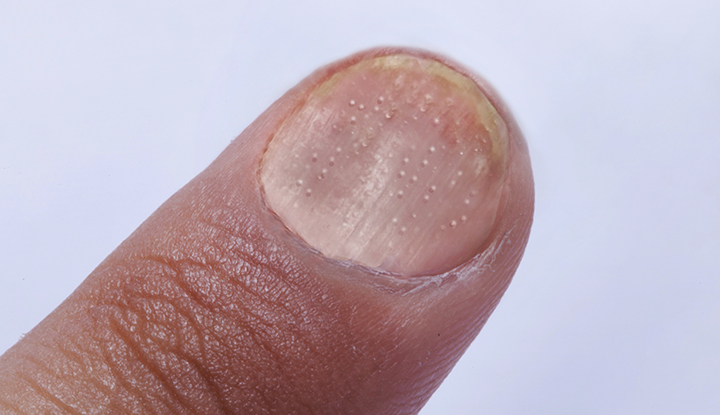Nail pitting is small, pin-poke dents in the nail plate of your fingernails or toenails. It’s usually a sign of psoriasis, but other conditions cause it, too. If you notice nail pitting, talk to your healthcare provider so they can help find and treat the cause. Treatment includes medications and prescription creams.
Advertisement
Cleveland Clinic is a non-profit academic medical center. Advertising on our site helps support our mission. We do not endorse non-Cleveland Clinic products or services. Policy

Nail pitting is when small dents, holes or grooves form in your fingernails or toenails. This makes your nails look uneven or bumpy instead of smooth.
Advertisement
Cleveland Clinic is a non-profit academic medical center. Advertising on our site helps support our mission. We do not endorse non-Cleveland Clinic products or services. Policy
Sometimes, if you hurt your finger, the top part of your nail (called the nail plate) might look rough for a while. That kind of damage usually heals as your nail grows out. But nail pitting is different. It’s not caused by an injury. The dents keep showing up in new nail growth. It can change how your nail looks and feels.
Nail pitting is often a sign of another health condition, like nail psoriasis. There are treatments that can help manage the cause.
Your nails might look like they have tiny pinpricks or deeper dents. They won’t be smooth. This can happen on just one nail or several. Sometimes, you might have only a few small pits that are hard to see. Other times, you might have a lot, making your nails look like the surface of a thimble.
Nail pitting is usually one of the first signs of nail psoriasis. Other changes to your nails may happen, as well. You might notice:
You may also feel embarrassed or self-conscious about how your nails look.
A healthcare provider can help figure out what’s causing these changes and recommend the right treatment.
Advertisement
The most common causes of nail pitting are psoriasis and psoriatic arthritis. About half of all people with psoriasis will have nail problems at some point in their lives.
Other health conditions can also lead to nail pitting, including:
Nail pitting can happen to anyone at any age, but it’s more common after age 40.
A vitamin deficiency doesn’t cause nail pitting. However, low levels of iron or zinc can lead to other nail problems, like Beau’s lines (horizontal ridges or dents) or spoon-shaped nails.
A healthcare provider can usually diagnose nail pitting by looking at your nails. They’ll also ask about your medical history and any other symptoms you might have.
To find out what’s causing the nail pitting, your provider may order additional tests, like:
To treat nail pitting, your healthcare provider will focus on the cause. Nails are often hard to treat with topical medicines alone. Your provider may suggest using both topical and oral medicines together, which could include one or more of the following:
These medicines may come as skin creams, pills or shots (injections). You may need more than one treatment. It can take a few months to see results because nails grow slowly.
Other treatments may also help, depending on your symptoms and how well the medicine works for you. Your provider will help you choose the best plan.
There’s no cure you can do at home to get rid of nail pitting. But if you have psoriasis or another skin condition, taking good care of your nails can help keep them as healthy as possible. Try these tips:
Advertisement
Nail pitting isn’t dangerous on its own, but it’s still important, and you shouldn’t ignore it. Because it’s usually a sign of another condition, it could get worse over time if you don’t treat it. In some cases, you could lose part or all of your nail.
Even though nail pitting isn’t serious, you should still let your healthcare provider know if you notice it or other changes in your nails. It’s important to find out the cause of the problem and get the right treatment to help manage it.
Your nails may be one part of your body that’s easy to overlook. You can hide them with nail polish or gloves. But at the end of the day, the dents or grooves from nail pitting will still be there.
The good news is that your healthcare provider can help you figure out what’s causing these divots to show up in the first place. Treatment options can help manage this symptom and the underlying cause. It may take some time to see results. But you don’t have to live with this symptom forever.
Advertisement
Last reviewed on 11/05/2025.
Learn more about the Health Library and our editorial process.